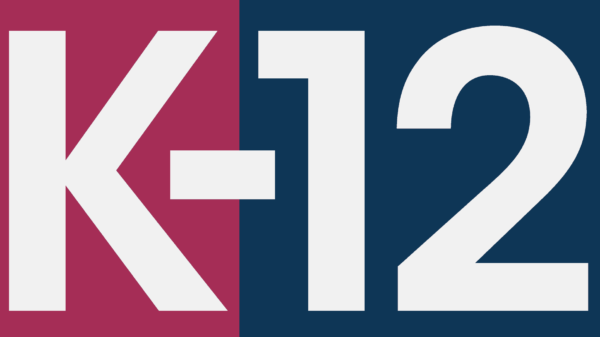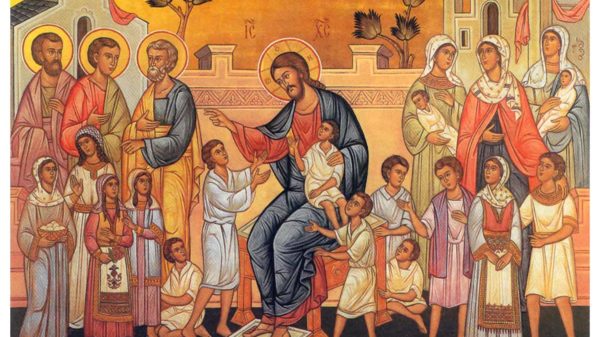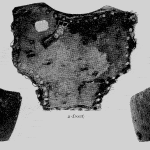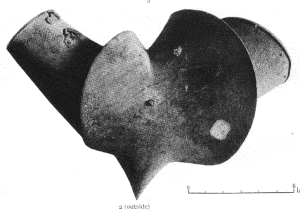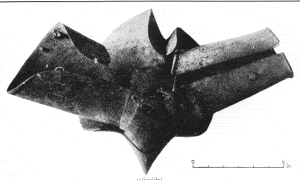IntroductionAlthough this article was penned early in the century, we include it here on the KCT site because it presents some valuable study photographs and notes on bascinets, sallets, barbutes and coats of plates.
The so-called Chalcis hoard was in large part eventually acquired by the New York Metropolitan Museum of art. Unfortunately, the “undisturbed” pieces Mr. Ffoulkes celebrates in his notes were along the way heavily modified to create “harnesses” of the period.
Although I have not been able to confirm this officially, I believe that portions of the famous Met “transitional suit” was made from pieces in this collection. Sadly, this reduced their quality, since it is generally aknowledged in the arms and armour community that this “restoration” contains several serious errors, including the treatment of the faulds, spaulders, greaves and cuisses. This harness has been, over the years, highly influential with re-enactors, owing to the scarcity of 14th century armour generally, and complete harnesses specifically. (only the famous Churburg #13 presents a more complete picture of what a knight of the late 14th century would wear)
This article should be interesting to students of arms and armour for several reasons. First, it contains several variant forms of the bascinet, complete with visors, which are generally seen only in manuscripts. Second, the outstanding condition of the 15th century Milanese arm harness was well photographed from two sides, something that might help armourers who aren’t able to secure the “bible” for Milanese armour, Lionello Boccia’s LE ARMATURE DI S. MARIA DELLE GRAZIE DI CURTATONE DI MANTOVA E L’ARMATURA LOMBARDA DEL ‘400, usually nicknamed simply “Mantova.” This book is a must-have, in any form, for Milanese armour of the period.
The author, Charles Ffoulkes, then curator for the Tower of London, was part of a thriving community of armour scholars who stood against the early 20th century tendency to “restore” pieces to their “new” condition, a practice which unfortunately ruined many otherwise valuable examples. He is today best known for his THE ARMOURER AND HIS CRAFT, still an important work and easily available from Dover.
Each of the photographs included herein appears on the page here in thumbnail form; clicking on it will take the browser to a larger photograph more suitable for detailed study. It is my hope to bring students of arms and armour ever more similar articles, both from the rich mines of my old ARCHEOLOGIA collection and from other sources, pending permissions.
For some years past a collection of helmets and portions of plate armour has been exhibited in the Ethnological Museum at Athens, which, in spite of the exceptional interest which attaches to it, has up to the present time escaped the serious consideration of writers on the subject of defensive armour of the Middle Ages. It is especially interesting because, from the time of the discovery of the collection to the present day, there has not been any attempt to restore or alter the condition in which the pieces were found, and when we consider the frequent mistakes made formerly, in other armouries, in this direction, this alone should recommend it to the study of those interested in mediaval equipment.
It was discovered in the year 1840, during some alterations to the military hospital in the Castle of Chalcis in Euboea, thirteen miles from Thebes, and, according to the historian Buchon, who was present at the discovery, was bricked up in a casement (un reduit) which was brought to light by the falling down of a party wall. Hefner, in his Trachten des christelichen Mittalalters (vol. i, p. 83), gives a plate of very indifferent reproductions of some of the helmets, and states that they were found in a cistern. This seems quite unlikely, from the condition in which most of the pieces must have been when last used, that they should have been intentionally walled up shortly before the evacuation of the castle, for they would have hardly been worth the trouble of preserving. But it seems far more probable that they were thrown aside as needing repair or as past repairing. Hefner gives no authority for his statement that they were found in a cistern, and Buchon only mentions the fact of their discovery, and does not give a detailed description of the place in which they were found.
Buchon’s knowledge of armour seems to have been but vague, for on the existing labels, which are attributed to him, we find 14th century bascinets and Venetian salades indiscriminately described as Casques normandes, Croisades du XXIIe Siecle.
In the notes on the discovery which Buchon gives in his La Grece et la Moree (p. 134), he suggests that this collection formed part of the spoil from the battle of Lake Copais, where the chivalry of Morea was defeated by the Catalan Grand Company in 1311. A mere glance at the armour, however, will show that this cannot have been the case, for there is little that could possibly be of so early a date.
The Castle of Chalcis was captured by the Turks from the Venetians in 1470, and it is the period from the middle of the 14th century to this date which exactly covers the style of helmets nad armour of which the collection is composed. The sole exception to this is a morion, which is stated to have been part of the find. If this is really the case then it is strange tha there should be no examples of the change of armour between the mid-15th and 17th centuries. Buchon does not mention the morion in the work above referred to, and it seems far more probable that it came from some other source, and has been included in the collection by accident.
There are at present sixty-three helmets in the collection, but the highest label number is ninety-five, and Buchon speaks of une centaine, so it is apparent that some of the specimens have been lost or disposed of.
Buchon mentions “Enormes Casques de Siege avec epauliers et leurs poitrails forme d’une seul piece de fer. La visire seule est mobile….” Either these helms are part of the lost specimens, or they are the bascinets, nos. 1,2,3 or 6,7 plate LII, which have no poitrails of a single piece of metal, and weigh only eight or nine pounds at the outside. He further states that a strong Maltese in his party could not wear one of them for more than ten minutes “without grave discomfort”. Against this we must place the fac that the helmets are practically unlined, and that the Maltese had no body-armour to take the weight of the helmet from his shoulders, for a headpiece of eight pounds resting on the shoulders could not possibly cause discomfort in such a short time.
Besides the helmets there are two large cases full of pieces of body-armour, cuisses, knee-cops, jambs, gauntlets, and portions of breast- and backplates. There is also a jazeran coat of plates, and a case full of arrow-heads and caltrops.
On the whole, the armour is in a fair state of preservation, though some of the helmets are partially destroyed by rust. There are no clues, heraldic or otherwise, as to the ownership of the armour, but some of the pieces bear armourers’ stamps.
The chief interest lies in the helmets, which in some instances bear traces of the original linings and coverings. Several are in good preservation, and have not been tampered with in any way. One of them still has the vervelles in place, but there is no chain-mail in the collection.
There are some good specimens of the great bascinet with collar and visor, which is more of the helm order than helmet, and of saledes there is great variety. Two of these are of the ordinary German type, with long tailpieces, but the greater number are essentially of Italian make, evolved directly from the bascinet, and fitting more closely than does the German variety.
There are several Venetian salades in good condition, with the T-shaped opening for the eyes and nose, a return to the form in favour of ancient Greece. The term “barbute” is often given to these helmets, or to the large bascinet with projecting cheek-plates. As a matter of fact, we are still uncertain as to the meaning of the word, except that it was a headpiece with some sort of chin protection; for Oliver de la Marche distinctly speaks of a la baviere de sa barbute.1The word barbute was also used for a man-at-arms, as we learn from DuCange. With regard to the word baviere, it is interesting to note that Buchon has transcribed the words bascinet a baviere as bachinet a banniere in his edition of St. Remy’s description of Agincourt, which shows how careless he was as to the descriptions of armour.
The body-armour seems to be mostly fourteenth century to mid-15th century style, and, with the exception of one or two brass-bound pieces, is plain or unornamented. There are a few pieces of slightly fluted in the Gothic fashion, which may be dated to the middle of the 15th century, but otherwise there is no elaborate embossing. There are no weapons in the collection except the arrow-heads before alluded to, and this suggests that if the hoard was known to the Turks they, being always more lightly armed than the Europeans, left the armour, but utilized the weapons that were found in the castle.
Buchon states that there were several pieces of armour for boys, but of this there is no evidence. Some arm- and legpieces are smaller than others, but all are for grown men, and he was probably misled by seeing separate jambs and vambraces without the knee- and elbow cops, which, when added, lengthened the defense.
An account of this collection appeared in the Courier Grec (Tachydromos), iv. 1841.
The following description of the illustrations embodies the notes and measurements made by Mr. Trequair, the numbers in brackets being those given on the museum labels.
 Plate LII, no 1 (II). Visored bascinet of the latter half of the 14th century, 11 inches high by 6 3/4″ in diameter (28 x 17cm), wieght 8lb 8oz (3.85 kilos). This helmet is almost cylindrical in shape, the lower edges bending slightly outward. The crown is embossed in four ridges, terminating in a point. It is formed of three plates: (1) the crown, riveted to the neck (2) and the left cheek-piece at about eye level, and (3) the right cheek piece hinged at about 1 1/2 inch below the lower ede of the crown. The right-hand plate has an oblong slot at the lower edge, which fits over a turning pin on the left neck-plate. The visor is missing, but the bolts on which it moved are still in place.
Plate LII, no 1 (II). Visored bascinet of the latter half of the 14th century, 11 inches high by 6 3/4″ in diameter (28 x 17cm), wieght 8lb 8oz (3.85 kilos). This helmet is almost cylindrical in shape, the lower edges bending slightly outward. The crown is embossed in four ridges, terminating in a point. It is formed of three plates: (1) the crown, riveted to the neck (2) and the left cheek-piece at about eye level, and (3) the right cheek piece hinged at about 1 1/2 inch below the lower ede of the crown. The right-hand plate has an oblong slot at the lower edge, which fits over a turning pin on the left neck-plate. The visor is missing, but the bolts on which it moved are still in place.
 No 2(12). A similar helmet with a narrow iron strip, fixed with brass rivets, crossing the crown from front t oback , pointed a the apex. The right cheek-piece is missing, and the left cheek piece is wider than that in no. 1, and is evidently meant to over- or under-lap the right. There is no turning pin or on this plate, and it is impossible to say how the plates were held together, unless a strap was used, as is the case with some armets and burgeonets of later date. The visor is missing in this example also. The weight and size are about the same as no. 1.
No 2(12). A similar helmet with a narrow iron strip, fixed with brass rivets, crossing the crown from front t oback , pointed a the apex. The right cheek-piece is missing, and the left cheek piece is wider than that in no. 1, and is evidently meant to over- or under-lap the right. There is no turning pin or on this plate, and it is impossible to say how the plates were held together, unless a strap was used, as is the case with some armets and burgeonets of later date. The visor is missing in this example also. The weight and size are about the same as no. 1.
 No 3(7). This is similar to the two preceeding examples, and of about the same size and weight. The crown is pointed, but is forged smooth and not ridged. The left cheekpiece shows the turning pin, as in #1, but the right cheek piece is missing. The visor remains, and is pivoted on brass bolts. The vison-slits of the visor are turned slightly outward. The profile of the visor slopes rather sharply from the crown of the helmet outwards, and then drops almost perpendicularly to the neck.
No 3(7). This is similar to the two preceeding examples, and of about the same size and weight. The crown is pointed, but is forged smooth and not ridged. The left cheekpiece shows the turning pin, as in #1, but the right cheek piece is missing. The visor remains, and is pivoted on brass bolts. The vison-slits of the visor are turned slightly outward. The profile of the visor slopes rather sharply from the crown of the helmet outwards, and then drops almost perpendicularly to the neck.
No 4(84). In this example the left cheekpiece has been destroyed by rust, and the right neckplate is also corroded. The right cheekpiece is missing, but the rivet holes of the hinge which held it in place can be seen.
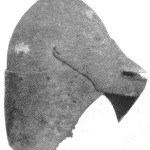 The visor is different in form than that of no. 3. It projects farther, and is more of the ‘snout-faced’ type. The vision-slit is not divided as in no. 3, but is a single opening, and is strongly turned outward on the lower edge. The left side of the visor is deeper than the right, and is interesting as being an early example of the reinforcing of armour on the side most opposed to attack from the lance. The inside of the crown is strengthened by an iron plate supported by a cross-straps of iron. As this example weighs 8lbs 4 oz (3.75 kilos) without the missing cheek-pieces, it must have been a heavy headpiece when complete. There are altogether twelve of these bascinets is more or less the same condition as those described, none of the examples being perfect in every detail, but by comparison of the illustrations with one another we can obtain a very correct idea of the perfect helmet.
The visor is different in form than that of no. 3. It projects farther, and is more of the ‘snout-faced’ type. The vision-slit is not divided as in no. 3, but is a single opening, and is strongly turned outward on the lower edge. The left side of the visor is deeper than the right, and is interesting as being an early example of the reinforcing of armour on the side most opposed to attack from the lance. The inside of the crown is strengthened by an iron plate supported by a cross-straps of iron. As this example weighs 8lbs 4 oz (3.75 kilos) without the missing cheek-pieces, it must have been a heavy headpiece when complete. There are altogether twelve of these bascinets is more or less the same condition as those described, none of the examples being perfect in every detail, but by comparison of the illustrations with one another we can obtain a very correct idea of the perfect helmet.
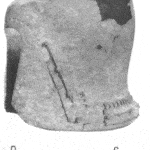 No. 5(86). This is a plain bacinet of rather earlier date than those already noticed. The crown has rusted away, but was most probably pointed, like those on many of the military brasses of the 14th century. The vervelles and attachment for the camail are still in situ in this example. The thin plate which covered the edge of the camail is perforated with trefoil decoration. In bascinets of this type the lines of the helmet generally fall rather sharply away from the face, following the slope of the vervelles and camail, but in this example the plates project well forward, which would seem to suggest that it was the immediate precursor of the collar of iron which is shown on the four preceeding examples. The helmet is forged in one piece, and has a slightly downward drop over the nose.
No. 5(86). This is a plain bacinet of rather earlier date than those already noticed. The crown has rusted away, but was most probably pointed, like those on many of the military brasses of the 14th century. The vervelles and attachment for the camail are still in situ in this example. The thin plate which covered the edge of the camail is perforated with trefoil decoration. In bascinets of this type the lines of the helmet generally fall rather sharply away from the face, following the slope of the vervelles and camail, but in this example the plates project well forward, which would seem to suggest that it was the immediate precursor of the collar of iron which is shown on the four preceeding examples. The helmet is forged in one piece, and has a slightly downward drop over the nose.
Nos. 6,8,9, 10 (25, 31, 50 47). These are plain bascinets of the ordinary type. From the position and number of the holes in 9, 10 is is doubtful whether these examples were worn with a camail, and they suggest rather that they were intended for the attachment of the lining. In no. 8, of which part of the right side is rusted away, the line of large holes sloping sharply backwards on the left plate indicates that vervelles were part of the furniture for the helmet. These bascinets average 6lbs 3 oz, (2.8 kilos) in weight, and some, of which no. 6 is an example, are about 14 inches high (35 cm), from which it will be obvious that they rested on the shoulders.
 |
 |
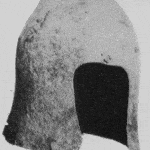 |
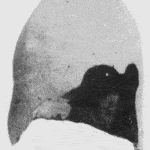 |
The workmanship of the bascinets is unequal, and this may be accounted for by the supposition that repairs or additions were made by the local armourers with the Venetian army at Chalcis, to helmets sent out from workshops of more expert craftsmen in Italy. The crowns appear to be skillfully forged, but some of the cheekpieces and visors are rather more clumsily made.
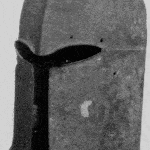 Nos. 7,11 (77,19). This type of helmet is usually known as the Venetian salade. By comparing it with the preceding examples it will be seen how it was directly evolved from the bascinet by bringing forward th cheek pieces and lowering the forehead line till the face was completely protectd with a rigid plate without any hinge or pivot. The form is very similar to no. 7. Both are forged in one piece, and have the lower edge of the back turned outwards, and the front edges strongly reinforced by a broad iron band fixed with brass rivets. These two examples are 11 in. (28cm) high and weigh about 6lb. 10 oz. (3 kilos).
Nos. 7,11 (77,19). This type of helmet is usually known as the Venetian salade. By comparing it with the preceding examples it will be seen how it was directly evolved from the bascinet by bringing forward th cheek pieces and lowering the forehead line till the face was completely protectd with a rigid plate without any hinge or pivot. The form is very similar to no. 7. Both are forged in one piece, and have the lower edge of the back turned outwards, and the front edges strongly reinforced by a broad iron band fixed with brass rivets. These two examples are 11 in. (28cm) high and weigh about 6lb. 10 oz. (3 kilos).
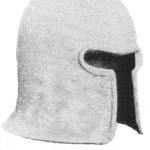 Of the same type of no. 11 there are altogether five examples, of which one only is perfect. They are all about 13 3/4 inches high (35cm), and vary in weight from 6lb 1 oz to 8 lb 13 oz (2.75 – 4 kilos), which is the weight of the example illustrated. The vision slits are slightly turned outwards, but the face-plates are flat edged. The shape of the helmets is cylindrical, with a slight outward bend at the base, all have ridged crowns. They are made in two pieces–the crown, and the lower plate riveted over the lower edge of the crown at eye level.
Of the same type of no. 11 there are altogether five examples, of which one only is perfect. They are all about 13 3/4 inches high (35cm), and vary in weight from 6lb 1 oz to 8 lb 13 oz (2.75 – 4 kilos), which is the weight of the example illustrated. The vision slits are slightly turned outwards, but the face-plates are flat edged. The shape of the helmets is cylindrical, with a slight outward bend at the base, all have ridged crowns. They are made in two pieces–the crown, and the lower plate riveted over the lower edge of the crown at eye level.
 No. 12 (42). Of this type there are six examples, four of which are in bad condition. The shape so nearly approximates to that of the bascinet of the early 15th century, and also to that of the early salade, that it is difficult to say under which heading they should come. The example before us is the only one which still shows the nasal, though some of the others have the hinge for its attachment. A helmet of this type is shown in the picture of the Rout of San Romano, (National Gallery 583) by Ucello. A similar specimen (E.1) in the Royal Armoury at Turin has spikes fixed on the outer side of the nasal, and has been catalogued by Angelucci as being of the 13th century.
No. 12 (42). Of this type there are six examples, four of which are in bad condition. The shape so nearly approximates to that of the bascinet of the early 15th century, and also to that of the early salade, that it is difficult to say under which heading they should come. The example before us is the only one which still shows the nasal, though some of the others have the hinge for its attachment. A helmet of this type is shown in the picture of the Rout of San Romano, (National Gallery 583) by Ucello. A similar specimen (E.1) in the Royal Armoury at Turin has spikes fixed on the outer side of the nasal, and has been catalogued by Angelucci as being of the 13th century.
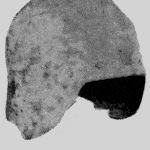 Plate LIII, Nos. 1-2 (80,60). A close-fitting salade with strongly marked ridged comb on the crown. No. 1 has a front reinforcing plate, scalloped on the upper edge, and ornamented round the face-opening with a row of brass studs. There are rivet-holes at the back , which seem too large for attaching the lining; and probably indicate that a tailpiece was fixed there. There are two more of this type, but without the ornamented plate. The example illustrated weighs 4 lbs 5 oz (1.95 kilos).
Plate LIII, Nos. 1-2 (80,60). A close-fitting salade with strongly marked ridged comb on the crown. No. 1 has a front reinforcing plate, scalloped on the upper edge, and ornamented round the face-opening with a row of brass studs. There are rivet-holes at the back , which seem too large for attaching the lining; and probably indicate that a tailpiece was fixed there. There are two more of this type, but without the ornamented plate. The example illustrated weighs 4 lbs 5 oz (1.95 kilos).
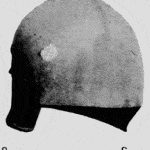 No. 2 is another salade of somwhat the same shape, but the sides are cut away at right angles to the forehead line, and not curved as in no. 1. There are two large holes at the side, which suggest that a visor formed part of this piece. The back is ornamented with brass rivets, which, from their position, and from the face that the lower edge of the salade is turned up and finished all round, do not appear to have fixed a tailpiece. Possibly the studes were to hold a covering of velvet or some other fabric, but there seems to be no trace of any material under the rivet-heads at the present day.
No. 2 is another salade of somwhat the same shape, but the sides are cut away at right angles to the forehead line, and not curved as in no. 1. There are two large holes at the side, which suggest that a visor formed part of this piece. The back is ornamented with brass rivets, which, from their position, and from the face that the lower edge of the salade is turned up and finished all round, do not appear to have fixed a tailpiece. Possibly the studes were to hold a covering of velvet or some other fabric, but there seems to be no trace of any material under the rivet-heads at the present day.
 No. 3 (47) is another variety of salade. The crown is slightly ridged at the top, abut becomes plain and smooth over the forehead, where the line drops sharply in a small nasal. The cheeks are cut away at each side on a curve, and the metal is cut out in a vertical slit about 2 1/2 inches high over each ear. The entire edge is pierced with holes for attaching the lining. The weight of this piece is 3 lb. 10 oz. (1.65 kilos), and there is a smaller specimen of the same type which weighs 2 lbs 5 oz. (1.05 kilos). The pictures and miniatures of the 15th century helmets of this type are often shown with a circular plates over the ears, which may possibly have been the case with this example, for it is hardly likely that the ears would have been left unprotected.
No. 3 (47) is another variety of salade. The crown is slightly ridged at the top, abut becomes plain and smooth over the forehead, where the line drops sharply in a small nasal. The cheeks are cut away at each side on a curve, and the metal is cut out in a vertical slit about 2 1/2 inches high over each ear. The entire edge is pierced with holes for attaching the lining. The weight of this piece is 3 lb. 10 oz. (1.65 kilos), and there is a smaller specimen of the same type which weighs 2 lbs 5 oz. (1.05 kilos). The pictures and miniatures of the 15th century helmets of this type are often shown with a circular plates over the ears, which may possibly have been the case with this example, for it is hardly likely that the ears would have been left unprotected.
There are six salades of the ordinary type with ridged crest, reinforcing plate over the forehead, and pivoted tailpiece. There is a hole in the centre of the ridge of each for fixing a plume or crest. The average weight is 2 lb 5 oz (1.05 kilos).
 No. 4 (64) is the back view of a headpiece. There is no ridge or crest on this example, and it is all forged in one piece. Over the ears of the metal is bossed out, a rather unusual contrivance necessitated by the close fit of hte helmet. The series of holes at the back, irsing in a line from the ears to the centre of skull, may have been for attaching a lining or covering; or for fixing a tailpiece.
No. 4 (64) is the back view of a headpiece. There is no ridge or crest on this example, and it is all forged in one piece. Over the ears of the metal is bossed out, a rather unusual contrivance necessitated by the close fit of hte helmet. The series of holes at the back, irsing in a line from the ears to the centre of skull, may have been for attaching a lining or covering; or for fixing a tailpiece.
Baron de Cosson has described a similar helmet in the Duc de Dino’s Collection, B.15 (now in the Metropolitan Museum, New York, K.50), which he considers to be of Spanish origin.
There are seven Turkish helmets of very thin metal, with high conical point terminating in small tassel-shaped ornament. These helmets are generally forged in two pieces, the point being welded on to the body of the skull-piece. A row of holes is pierced two inches above the baseline; in one specimen a link of mail still hangs. This can hardly have been the original use for the holes, as they are much to high for hanging the mail, unless vervelles were used, and of these there is no sign. Where Turkish helmets are fitted with a camail the rings are hung from the extreme lower edge. The average weight is about 1 lb. 12 oz. (.8 kilos).
 The hingeplates to which the visor was pivoted are still in place on no. 5. The face opening is strengthened by a strip of iron of square section round the edge of the skill and cheekpieces. At the back of the neck is a square pin which held the circular disc which is found on armets of this date, the use of which was probably to protect the weak spot in the helmet, where the narrow neck or tailpiece meets the cheekplates. The remains of a leather strap are seen on no. 6. To this strap was formerly hung the short camail which protected the juncture of the armet and gorget. The average height is 10 in (25 cm) and weight 9 lb 10 oz (3 kilos).
The hingeplates to which the visor was pivoted are still in place on no. 5. The face opening is strengthened by a strip of iron of square section round the edge of the skill and cheekpieces. At the back of the neck is a square pin which held the circular disc which is found on armets of this date, the use of which was probably to protect the weak spot in the helmet, where the narrow neck or tailpiece meets the cheekplates. The remains of a leather strap are seen on no. 6. To this strap was formerly hung the short camail which protected the juncture of the armet and gorget. The average height is 10 in (25 cm) and weight 9 lb 10 oz (3 kilos).
In all three examples there are large brass studs at intervals round the lower edge. Owing to the obvious weakness of this type of armet, in which the lack of a hook or catch renders the visor liable to be struck upwards, a beavor or mentonniere was generally worn in addition; as may be seen in the battle-pieces of Paolo Ucello, but there appears to be no example of this type of plate armour in the collection.
Armets of this date are rare in collections, and, where they exist, there is often a serious doubt as to their authenticity. In this instance, however, there can be no such question, as the date of the capture of the castle places them definately before 1470. The same type seems to have been in use for a long period, for, as Viscount Dillon has pointed out, the armet which forms part of the Engraved Suit in the Tower made by Seuseunhofer (II, 5), is modelled on the same lines, though its date is forty-four years later than the specimens before us.
 Plate LIV, nos. 1-3 (145, 76, no number). These are breast- and backplates which reinforced brigandines. No. 1 for the right breast, has the toothed bracket to which the lance-rest was affixed. The teeth are bored vertically with square holes, through which the square-shanked pin was passed to hold the lance rest in position. These plates are not common in armouries, and are very rare when in their original state on the brigandine.
Plate LIV, nos. 1-3 (145, 76, no number). These are breast- and backplates which reinforced brigandines. No. 1 for the right breast, has the toothed bracket to which the lance-rest was affixed. The teeth are bored vertically with square holes, through which the square-shanked pin was passed to hold the lance rest in position. These plates are not common in armouries, and are very rare when in their original state on the brigandine.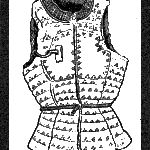 An almost perfect specimen exists in the Imperial Collection at Vienna (Saal XXV, no. 130). dated about 1500, a sketch of which will be found at figure I. The rivets set round the edge of the plate formerly attached a covering of the fabric similar to that which covered the rest of the brigandine. At the back of this plate is an armourer’s mark (fig. 2) repeated six times in pyramidical form. The letters are identical with those use dby Antonio da Missiglia who was working in Milan from 1451-1490. The known marks of Antonio are either surmounted by a knot or a cross with divided base (fig. 3), but the similarity of the form of the letters is too striking to be passed over.
An almost perfect specimen exists in the Imperial Collection at Vienna (Saal XXV, no. 130). dated about 1500, a sketch of which will be found at figure I. The rivets set round the edge of the plate formerly attached a covering of the fabric similar to that which covered the rest of the brigandine. At the back of this plate is an armourer’s mark (fig. 2) repeated six times in pyramidical form. The letters are identical with those use dby Antonio da Missiglia who was working in Milan from 1451-1490. The known marks of Antonio are either surmounted by a knot or a cross with divided base (fig. 3), but the similarity of the form of the letters is too striking to be passed over.
No. 3 is a similar piece of larger size, but without a lancerest; it is also fo rthe right breast, and still retains portions of the original covering of two thicknesses of fabric under the rivetheads. A strip of iron is riveted on to the edge of the armspace. The mark in this piece is three rosettes (fig. 4), which at present has proven impossible to trace elsewhere.
No. 2 is a backpiece, still covered with coarse canvas underneath and a finer material above, woven with a diagonal diaper pattern. The fragments under the studs where the material has not fased are red and yellow. On the left side is part of a green canvas strap. There are no breast- and backpieces of the ordinary type.

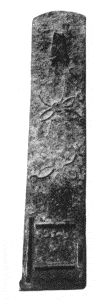
Plate LV, No. I. A tapering iron plate 24in. long (61cm) with a thin tang at the broad end, decorated with brass ornaments riveted on. Its use is unknown. It is bent at an acute angle, so a photograph was taken of the two portions separately.
There are a number of jambs, cuisses, and knee-cops of the same date. In one example a jamb has a turning pin a tthe top, to which the knee-cop was fixed, so that the lower defense could be quickly removed, an expedient which must have often been found necessary in forced marches or in fighting over difficult ground. The only piece worth illustrating is the portion of a cuisse shown on plate LV, no. 3, which has a hinged backplate, showing that it was used by a man who fought on foot and never rode. The statuette of St. George at Dijon Cathedral shows half-plates hinged to the cuisse in a similar manner.
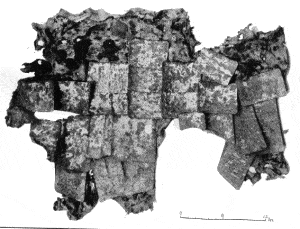 There is also a part of a coat of jazeran armour (plate LIII), composed of overlapping plates varying in size from 5 by 3 1/2 ti 7 by 3 in (12 by 4 to 18 by 8 cm). The upper part is formed of plates sewn horizontally on a double thickness of coarse canvas, while the lower portion the plates are sewn upright. The lower part is cut away in two semicircular openings at back and front for convenience on horseback, the long side strips protecting the thighs, as was the case with the Norman hauberk. It is probably of Oriental origin.
There is also a part of a coat of jazeran armour (plate LIII), composed of overlapping plates varying in size from 5 by 3 1/2 ti 7 by 3 in (12 by 4 to 18 by 8 cm). The upper part is formed of plates sewn horizontally on a double thickness of coarse canvas, while the lower portion the plates are sewn upright. The lower part is cut away in two semicircular openings at back and front for convenience on horseback, the long side strips protecting the thighs, as was the case with the Norman hauberk. It is probably of Oriental origin.
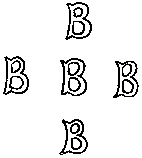 |
 |
 |
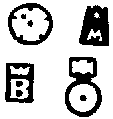 |
Of the other armourers’ marks illustrated (figs 5-10), which are found on plates similar those on plate LIV, none resemble any known stamps except fig. 5, which seems to be the same as an unidentified mark on a salade at Madrid (D.14), figured on fig. 6.
It is hoped that the museum authorities at Athens will catalogue the whole collection under proper headings, even if Buchon’s labels are retained from sentimental interest. It may be that further examination may bring to light other interesting details which will help to identify some of the individuals who garrisoned the castle. Such stores of armour found in one place, left untouched by the restorer’s hand, are rare, and are of the greatest use in the study of defensive armour.
In conclusion, I must express my indebtedness to Mr. Ramsay Traquair and Mr. H. H. Jewell for photographs and minute notes and measurements of the armour and helmets, made for the Byzantine Research and Publication Fund, to Mr. F.W. Hasluck, Assistant Director of the British School at Athens, and to Dr. Radoz, Director of the Ethnological Museum, Althens.
For various reasons it has been found practically impossible to bring all the photographs down to the same scale, so a separate scale is given in each case.






